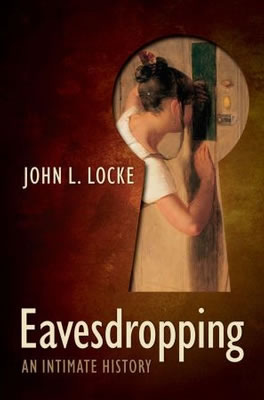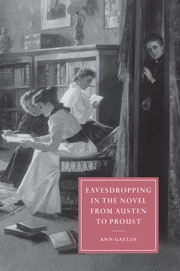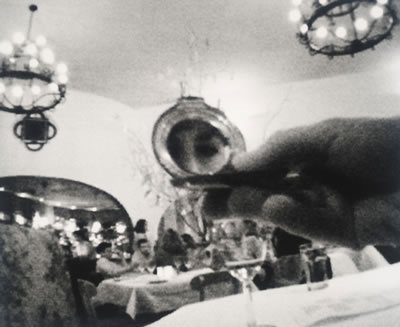Would you read your daughter’s diary? Have you ever surreptitiously rifled through the pockets of a lover you suspect of betrayal – or peeped at their text messages? Have you ever peered through a keyhole or hung around a closed door at work, knowing that a confidential meeting is going on and hoping for raised voices? If so, you’re following in an ignoble tradition.
 While we may deplore the efforts of our government to find out more and more about us in the name of security, and fear the intrusions of CCTV cameras in every crevice of our lives, we don’t always admit how much we ourselves love to pry, to uncover secrets, to know the naked truth.
While we may deplore the efforts of our government to find out more and more about us in the name of security, and fear the intrusions of CCTV cameras in every crevice of our lives, we don’t always admit how much we ourselves love to pry, to uncover secrets, to know the naked truth.
Tate Modern’s new exhibition “Exposed” sets out to raise questions about the extent to which we are being watched: by governments, by the police, by our bosses at work, by nosy neighbours or by jealous lovers.
The need to maintain a barrier against the outside world may be one of our most basic human urges; but another is the lust to know the unknown, to observe and indulge in the privacy of others. In his book The Presentation of Self in Everyday Life the sociologist Erving Goffman demonstrates how we all perform in various guises and to different groups of people, as if we were on stage. We preserve our “backstage” selves as an essential part of our identity – and it is this protected part of our personality that we attempt to mask, while harbouring a strong desire to penetrate those of others. So eavesdropping is at the same time one of the most tempting and yet most reviled of human activities. And it is at its most ignoble and most vicious in that most democratic of institutions: the media. Thirsty for freshly tillitating revelations and, even better, candid pictures of indiscretion, they’re modern-day peeping toms, scurrilous sneaks, telltales. In this, the British press is a faithful follower of the time-honoured tradition of eavesdropping: they are the butler peering through the keyhole to tell us what he saw; the window cleaner who can peek through glass into private realms.
 In a new book John Locke traces the history of this most despised and yet universal example of aberrant behaviour. And he reveals it has always carried something of a double standard. In the Middle Ages, for example, eavesdropping was illegal in England. But at the same time, eavesdroppers might also be called to give evidence in court, lascivious details and all.
In a new book John Locke traces the history of this most despised and yet universal example of aberrant behaviour. And he reveals it has always carried something of a double standard. In the Middle Ages, for example, eavesdropping was illegal in England. But at the same time, eavesdroppers might also be called to give evidence in court, lascivious details and all.
Our recoiling from the voyeur is at least in part a recognition that we share this desire to invade the private spaces of others. And it’s a drive that is universal. The English term “eavesdropping”, Locke writes, derives from the practice of standing under the eavesdrop – the place where rain water falls from the roof to the ground – in order to overhear conversations taking place indoors. In French, to eavesdrop is ecouter aux portes, listen at doors, as is the Italian equivalent origliare alla porta. In Spanish, escuchar sin ser isto means to listen without being seen. In Tzotzil, a language spoken in the Mexican Highlands, there is a verb that means “to observe in secret, from a hiding place.” In Swedish, a tjuvlyssnare is a “listen-thief” while the Russian pod slushivanye means to “underlisten”.
Locke also points out that the most perennial eavesdroppers have tended to be those with the most opportunity, and the biggest motive to do so: the servants. In earlier times when a household relied on armies of them, their knowledge of the “backstage” lives of their employers bestowed a kind of power over those who had power over them.
“Servant testimony was rich in intimate details – of morning erections in allegedly impotent husbands, beds that were ‘tumbled’ and stained sofas indented by the backs of unfaithful wives, and gentleman callers struggling to regain their composure as they buttoned up their breeches. The stories of servants and their masters read like novels . . . virtues like obedience, loyalty and honour juxtaposed with contempt, betrayal and shame. Inevitably the possibility of bribery and blackmail lurked.”
And opportunities to glimpse the private lives of their masters were rife. In the 16th and 17th centuries servants would live and sleep in close proximity to their employers so as to be on hand to serve them at any time. Gradually, though, as the awareness of the need for privacy grew, devices were developed to separate upper-class families from those who served them. Bells were installed so that servants could be summoned; the dumbwaiter was introduced so that they would not need to be present during meals. And perhaps most useful of all was the simple device of the key escutcheon, a metal plate with a swinging cover that obscured the keyhole.
But it was not until the 19th century that the notion of privacy began to become an obsession. And, according to Ann Gaylin in her study of literary eavesdropping, that is why it became so central to the novel. She quotes the Russian philosopher Mikhail Bakhtin, who asserts: “The literature of private life is essentially a literature of snooping about, of overhearing ‘how others live’ . . . What matters are the everyday secrets of private life that lay bare human nature – that is, everything that can be only spied and eavesdropped upon.”
 Ann Gaylin agrees that eavesdropping has always been used as a device to propel literary plots, right from the classical Greek dramas. Think of Polonius, reaping the ultimate punishment for lurking behind the curtain in Hamlet, or the covert eavesdropper Orgon who is so outraged when he witnesses the debauched antics of Moliére’s Tartuffe that he jumps out of his hiding place and blows the plot to unfrock the hypocrite.
Ann Gaylin agrees that eavesdropping has always been used as a device to propel literary plots, right from the classical Greek dramas. Think of Polonius, reaping the ultimate punishment for lurking behind the curtain in Hamlet, or the covert eavesdropper Orgon who is so outraged when he witnesses the debauched antics of Moliére’s Tartuffe that he jumps out of his hiding place and blows the plot to unfrock the hypocrite.
But, argues Gaylin, it is not until the 19th century that eavesdropping becomes such a crucial plot device. Heathcliff is driven away when he hears Catherine asserting that it would degrade her to marry him. The plot of Pride and Prejudice is set in motion when Elizabeth Bennet overhears Darcy’s disobliging remarks about her; just as that of Persuasion is almost derailed when Anne Elliot, sitting behind the hedgerow, witnesses Louisa Musgrove’s flirtation with Captain Wentworth, and is resolved when Wentworth overhears Anne’s defence of female constancy. The novels of Balzac all depend heavily on what is accidentally or deliberately overheard – Old Goriot, for example, is set in a boarding house where everyone is a spy and a gossip.
And this overriding passion for privacy, Gaylin believes, arose from the increase in the flow of information. “By making information more available to a larger public, institutions such as the penny post, the telegraph and newspapers transformed local events into potentially national knowledge. Although the division of public and private spheres of activity emerged earlier, it is in this era that the desire to distinguish between the two became keenly felt.”
So the separation of the domestic from the public was central to Victorian ideology; family, home and hearth were constantly portrayed as a sacred preserve, free from worldly concerns and the demands of business. Terror of having this purity sullied was exacerbated by the rise, during this era, of a new breed of eavesdropper: the private detective.
In one sense, the newly arrived Victorian detective was a figure of reassurance, conviction, certainty. But he was also deeply resented. In her account of a notorious 19th-century murder, The Suspicions of Mr Whicher, Kate Summerscale describes how far the detective was able to intrude into domestic space. “Many felt that Whicher’s inquiries culminated in a violation of the middle-class home, an assault on privacy, a crime to match the murder he had been sent to solve. He exposed the corruptions within the household: sexual transgression, emotional cruelty, scheming servants, wayward children, insanity, jealousy, loneliness and loathing. The scene he uncovered aroused fear (and excitement) at the thought of what might be hiding behind the closed doors of other respectable houses. His conclusions helped to create an era of voyeurism and suspicion, in which the detective was a shadowy figure, a demon as well as a demi-god.”
This generalised anxiety about the need to protect the private, domestic sphere from outside intrusion is, according to Gaylin, manifested in developments in 19th-century architecture. “Innovations such as the introduction of the corridor and the individualisation of rooms demonstrate how architects incorporated notions of privacy and domestic ideology into the design of houses.”
Erving Goffman also cites domestic architecture as a telling illustration of the line dividing front and back regions in human interaction. “In all classes in our society there is a tendency to make a division between the front and back parts of residential exteriors. The front tends to be relatively well decorated, well repaired, and tidy; the rear tends to be relatively unprepossessing. Correspondingly, social adults enter through the front, and often the socially incomplete – domestics, delivery men, and children – enter through the rear.”
Even that most time-honoured of divisions, the wall, is a form of social technology. “When people went behind walls,” argues Locke, “eavesdropping was needed to re-establish sensory contact.” Walls may have originally been devised as barriers against the outside world, he explains, but they also kept domestic activities safely on the inside.
But, Gaylin points out, such a division is illusory. “Despite the 19th-century obsessive division of space into smaller and smaller units, with discrete functions assigned to each, walls, particularly in the subdivided former hotels privés of Restoration Paris, provide visual isolation; they seldom block out noise completely. Instead, people learn to disregard the coughs, shouts, or moans on the other side of the wall.”
But there is a difference between those who might overhear unwittingly, and those who set out to eavesdrop. Gaylin notes that for Dickens, the deliberate eavesdropper is always a villain, while those who overhear by accident tend to be innocent – like poor Florence in Dombey and Sons who discover, through overhearing quite how much her father despises her.
Indeed, children in literature frequently mishear or misunderstand what they have witnessed – and this often provides a critical impetus for the story. The plot of Ian McEwan’s Atonement, for example, hinges on the false evidence of Briony who mistakenly believes that the encounter she has seen between Cecilia and Robbie is a rape. The child Go-Between in L.P. Hartley’s claustrophobic portrayal of a mismatched love affair is an unwitting eavesdropper, only half-understanding the messages he has to convey and then betray. Perhaps the most famous literary child eavesdropper is Henry James’s heroine in What Maisie Knew, who is used as a pawn in the corrupt power games of the adults around her, and can only report a partial, distorted version of what she observes.
And children are the archetypal eavesdroppers because, traditionally, covert prying has been their only way to discover the secrets of the adult world. In his book No Sense of Place Joshua Meyrowitz draws a contrast between past and present experiences of childhood. “What a young child knew about the world was once determined primarily by where the child lived and was allowed to go. . . Although the child is not completely isolated from information about the outside world, this information is generally filtered through parents and other adults.”
Lurking in hallways, head between the banisters upstairs, peering through windows, ears pressed to doors or floorboards, children have always gleaned what they can through covert spying. And it is only recently, argues Meyrowitz, that this mode of operation has begun to be eroded by the technological age. By watching television, children can now view adult life without the mediation of parents. “Television,” he claims, “now escorts children across the globe even before they have permission to cross the street.”
John Locke goes even further, arguing that rather than acting as a substitute for eavesdropping, television, along with social networking channels like Facebook and Twitter, is a modern version of it. But there is a vital difference: these media are designed for public consumption. They are, in Goffman’s terms, front stage. However real Eastenders may seem, however intimate those messages on Facebook, everyone knows they have been deliberately placed in the public arena.
But there is one burgeoning genre of broadcast entertainment that blurs the distinction between front and backstage. Reality television shows are just as contrived as scripted dramas, while giving the impression of unplanned spontaneity. Even the title of Big Brother, redolent with Orwellian connotations, helps to give the impression that the viewer is watching what is meant to be secret. But as Annette Hill points out in her audience study Reality TV, viewers are well aware of the constructs that create the programme. What they love to do is spot the unwitting revelation, to try and identify when participants are, indeed, showing their backstages. And it is this – the moment when George Galloway turns into a fawning kitten, when the late Jade Goody racially abuses a contestant – that provides the thrill of the eavesdropper.
 In most social interaction, though, as Goffman points out, there is a “natural movement back and forth between cynicism and sincerity” on behalf of performers and their audiences. Most of the time, though, we adopt masks and personae in order to preserve that core that we regard as our true self. But such protection is not granted to the religious. If you believe in God you have no safe haven. For God is everywhere. You can’t hide from him and you can’t disguise your thoughts for, as we all know, conceiving of a wicked deed is the same as committing it. And God can read your mind.
In most social interaction, though, as Goffman points out, there is a “natural movement back and forth between cynicism and sincerity” on behalf of performers and their audiences. Most of the time, though, we adopt masks and personae in order to preserve that core that we regard as our true self. But such protection is not granted to the religious. If you believe in God you have no safe haven. For God is everywhere. You can’t hide from him and you can’t disguise your thoughts for, as we all know, conceiving of a wicked deed is the same as committing it. And God can read your mind.
Faith and religious observation must penetrate even the most intimate areas of life: when and how to have sex; what position is purest for sleeping ; the right way to wash your hands, to go to the lavatory, to dress and undress what and when to eat and drink.
And since there is no provision for a self that is separate, religion denies one vital aspect that makes us truly human. The Almighty God – the ultimate, all-knowing, jealous, loving, punishing, demanding, totally omniscient, powerful being – is the original eavesdropper; watch out, or He’ll steal your soul.
Eavesdropping: A History by John Locke is published this month by Oxford University Press. "Exposed: Voyeurism, Surveillance and the Camera" is at Tate Modern 28 May- 3 October.
Images above courtesy of The Tate

